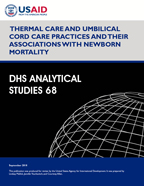Thermal Care and Umbilical Cord Care Practices and Their Associations with Newborn Mortality

The global public health agenda spotlight is increasingly focused on reducing preventable newborn deaths. Skilled care at birth and delivery in a health facility equipped with life-saving medical technologies is a clear path to prevention. However, many women continue to deliver at home, impeded by lack of access to a health facility, concerns of sub-par quality at nearby facilities, or financial constraints where healthcare is not well subsidized.
Steps can be taken immediately after birth that may improve the chance of newborn survival and can be applied with nominal costs. Keeping infants warm—thermal care—and preventing infection where the umbilical cord was cut—hygienic cord care—are two key practices.
The DHS Program undertook efforts in 2014 in order to improve the assessment of newborn care practices. They worked with the recommendations from the Newborn Care Technical Working Group to:
- Develop an optional Supplemental Module on Maternal Health Care with a standardized set of questions assessing newborn care. This module collects information on drying, bathing, cord cutting, and cord care including the application of chlorhexidine.
- Add questions to the DHS-7 core questionnaire regarding care at the time of birth, pre and post-discharge contacts for mothers and newborns, the content of postnatal care for newborns, and other essential newborn care practices (immediate skin-to-skin, early initiation of breastfeeding).
Questions related to thermal care and cord care have been included in some DHS surveys since 2003, a total of 16 surveys conducted between 2003-2016 in 10 countries: Bangladesh, Ethiopia, Ghana, India, Morocco, Nepal, Nigeria, Pakistan, Sierra Leone, and Timor Leste.
A Journal of Global Health Collection on Measuring Coverage of Essential Maternal and Newborn Care Interventions: An Unfinished Agenda issued a call for action to use these data to track progress over time and make comparisons between countries in order to assess whether newborns are receiving life–saving interventions, prompting The DHS Program to conduct further analyses.
This recent DHS Analytical Study (68) sought to explore three things: 1) what’s been happening with these practices over time; 2) is there an association between these practices and newborn deaths among home births; and 3) what factors predict these practices among home births? The analysis includes an in-depth exploration of newborn care in three South Asian countries: Bangladesh, India, and Nepal.
Key Findings
- In countries with more than one survey available, coverage of recommended thermal care and hygienic cord care practices increased over time, with more frequent application among facility births than home births.
- Among home births in South Asia, skilled care during pregnancy and birth increased the odds of receiving the recommended practices.
- In Bangladesh and Nepal, application of an antiseptic (chlorhexidine or an unspecified antibiotic or antiseptic) to the cord was highly protective against newborn mortality compared with dry cord care.
- Among newborns who died, there was a high proportion of missing responses regarding recommended behaviors.
These findings highlight the importance of cord care in preventing newborn mortality as well as the importance of skilled care during pregnancy and birth for the implementation of recommended practices. Although thermal care did not predict newborn survival, sample size and missing cases limited the analyses. The findings also suggest that the recall or reporting of details around the traumatic event of newborn death may be incomplete.
While the analysis could not control for all potential cofactors of newborn mortality and receipt of care, this report provides additional insight on important predictors of these outcomes in several countries, including mothers’ education, household wealth, and maternal age as well as the sex of the baby.
A research article adapated from this report can be found on the BMC Pediatrics Journal.
Photo Credit: © 2011 Faisal Azim, Courtesy of Photoshare
Written by Jennifer Yourkavitch and Lindsay Mallick
 Jennifer Yourkavitch, MPH, PhD, IBCLC is an epidemiologist whose research and program work focuses on documenting and addressing determinants of health, particularly in relation to lactation and breastfeeding practices; maternal and child health and nutrition; HIV/AIDS, malaria and other infectious diseases; gender; equity; health systems; and, service delivery around the world. In her 14 years with ICF, Dr. Yourkavitch has helped various clients to plan, implement, monitor and evaluate health programs, including WHO, USAID, PMI, CDC, and dozens of NGOs. She conducts population health research with the Demographic and Health Surveys Program and the University of North Carolina in Chapel Hill and Greensboro.
Jennifer Yourkavitch, MPH, PhD, IBCLC is an epidemiologist whose research and program work focuses on documenting and addressing determinants of health, particularly in relation to lactation and breastfeeding practices; maternal and child health and nutrition; HIV/AIDS, malaria and other infectious diseases; gender; equity; health systems; and, service delivery around the world. In her 14 years with ICF, Dr. Yourkavitch has helped various clients to plan, implement, monitor and evaluate health programs, including WHO, USAID, PMI, CDC, and dozens of NGOs. She conducts population health research with the Demographic and Health Surveys Program and the University of North Carolina in Chapel Hill and Greensboro.

Lindsay Mallick joined The DHS Program via Avenir Health in 2014. As a Senior Research Associate for The DHS Program’s Analysis team, she conducts research using data from both DHS and SPA surveys on health services and outcomes related to reproductive, maternal, newborn, and child health. She has an MPH in International Health and Development from Tulane University and served in the Peace Corps in Mauritania, West Africa. Prior to joining The DHS Program, Ms. Mallick fulfilled two consecutive fellowship roles as an epidemiologist for the US Air Force and then the US Army.



thank you for this article this helps me a lot